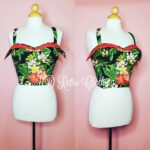Buy the Professional Dress Here
I love making dresses but most of the dresses I make are a little low cut in the front. I want to make something pinup that still can easily be worn in an office setting. Scouring through my vintage library and after a brief poll, I found a choice.

I have a few different fabrics that I have been holding onto for various future inspirations. This fabric was fun and still perfect for an office setting.

@hollydai7 I wanted to make a work appropriate pinup dress and voila. ##vintagesewing ##vintagegirl ##pinup ##sewing
I did a quick test on the mannequin to see how the top was looking. I love it!
African wax prints did not originate in Africa but were continued and popularized by African people. In 1852 Indonesian textiles were very popular, using a dying processed called, “batik.” The orgin of wax print began with Piet Snel. On a trip to his uncle’s sugar plantation on the island of Java, also what was known as the Dutch East Indies and now present Indonesia, he became enamored with the technique. Fabric samples that utilized this wax resistant method, were sent back home. Frits, or Frederik ‘Frits’ Hendrik Fentener van Vlissingen asked his nephew, Piet, to figure out a way to create the intricate, detailed, and extremely long process of batiking, into a fast and inexpensive way to make fabric for the market. However, often there was small imperfections from the wax seeping through and in many cases the fabrics were banned.
Wax fabrics then found an unexpected new home starting in Ghana (then known as the Gold Coast), because between 1855 and 1872 approximately 3,000 Ghanian soldiers served in the Royal Netherlands East Indies Army. Upon return, many of the soldiers brought back their appreciation for the textiles and didnt mind the crackle effect.
Dutch Wax found its market place in many African countries. “Today, the Vlisco Group has four brands: Vlisco, Woodin, Uniwax, and GTP (Ghana Textiles Printing Company). The latter three are produced in parts of Africa, and all four market their slightly different designs to slightly different segments of that continent’s marketplace.”
The Dutch Wax is such a unique printing process, it reminds me much of pressing wood blocks to a card press. When you purchase a design, it is usually in 6 yard segments. o learn more about the history of Dutch wax, I have sited an article here.
Want your own “Professional” check it out here!


